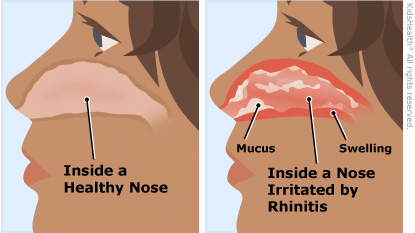Kids with non-allergic rhinitis (rye-NYE-tis) get stuffy or runny noses but they don't have allergies or an infection. Here is some information to help your child feel better.



Your child:

What is rhinitis? Rhinitis means inflammation (irritation and swelling) of the nose. An inflamed nose makes a lot of mucus, so someone with rhinitis will have a runny or stuffy nose. They may sneeze a lot and have postnasal drip (mucus that runs down the throat).
What causes rhinitis? In kids, allergies or infections (like a cold or the flu) are the most common causes of rhinitis. Rhinitis from other causes is called non-allergic rhinitis. It can happen because of changes in temperature or humidity; exercise; strong odors, pollution, or smoke; or by eating spicy or hot foods. Some kids get non-allergic rhinitis due to hormonal changes during puberty or the menstrual cycle. Some types of medicines also make kids more likely to get non-allergic rhinitis.